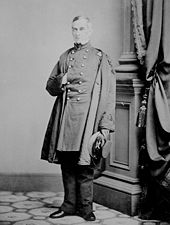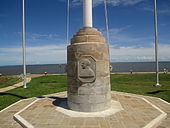Robert Anderson (Civil War)
Robert Anderson | |
|---|---|
Department of the Cumberland Fort Adams | |
| Battles/wars | |
Robert Anderson (June 14, 1805 – October 26, 1871) was a United States Army officer during the American Civil War. He was the Union commander in the first battle of the American Civil War at Fort Sumter in April 1861 when the Confederates bombarded the fort and forced its surrender to start the war. Anderson was celebrated as a hero in the North and promoted to brigadier general and given command of Union forces in Kentucky. He was removed late in 1861 and reassigned to Rhode Island, before retiring from military service in 1863.
Early life and career
Anderson was born at "Soldier's Retreat," the Anderson family estate near
A few months after graduation, he became a private secretary to his older brother
Returning to regular Army service as a
In the
Due to his wounds, Anderson was on sick leave of absence during 1847–48. He was then in garrison at Fort Preble, Maine from 1848 to 1849. He then served from 1849 to 1851 as a member of the Board of Officers to devise "A Complete System of Instruction for Siege, Garrison, Seacoast, and Mountain Artillery," which was adopted on May 10, 1851. He then returned to garrison duty at Fort Preble from 1850 to 1853.[3]
From 1855 to 1859, in view of his precarious health and probably also due to his connections to General Winfield Scott, Anderson was assigned to the light duty of inspecting the iron beams produced in a mill in Trenton, New Jersey for Federal construction projects. (While residing in Trenton, Anderson became a
Civil War
Fort Sumter

In November 1860, Anderson was assigned to command of U.S. forces in and around
Status as national hero
Anderson's actions in defense of Fort Sumter made him an immediate national hero.
Symbolism of the American flag
The modern meaning of the
responded with a "feast of the American flag." Eyewitnesses estimated that as many as 100,000 flags quickly went on display across the city. To punctuate this feast of national colors, New York's graphic artists rushed out patriotic engravings and lithographs depicting avenging soldiers or gowned goddesses, bayonets upthrust, carrying "The Flag of Our Union" into future battles that, at the time, could only be imagined. Composers dedicated songs like "Our Country's Flag" to President Lincoln, and adorned their published sheet music with colorful images of resolute soldiers gripping the national banner.[6]
During the war, the flag was used throughout the North to symbolize American nationalism and the rejection of secessionism. Goodheart explained that the flag was transformed into a sacred symbol of patriotism:
Before that day, the flag had served mostly as a military ensign or a convenient marking of American territory ... and displayed on special occasions like the Fourth of July. But in the weeks after Major Anderson's surprising stand, it became something different. Suddenly the Stars and Stripes flew ... from houses, from storefronts, from churches; above the village greens and college quads. ... [T]hat old flag meant something new. The abstraction of the Union cause was transfigured into a physical thing: strips of cloth that millions of people would fight for, and many thousands die for.[7]

Assignments
Anderson then went on a highly successful recruiting tour of the North and was promoted to brigadier general as of May 15, 1861. His next assignment placed him in another sensitive political position as commander of the Department of Kentucky (subsequently renamed the
Speed met with Anderson and found him reluctant to implement Lincoln's wishes to distribute rifles to Unionists in Kentucky. Anderson, Speed wrote to Lincoln on October 8, "seemed grieved that [he] had to surrender his command ... [but] agreed that it was necessary and gracefully yielded."
In 1862, Anderson was elected an honorary member of the New York Society of the Cincinnati in which his grandnephew, Ambassador Larz Anderson, was highly active.
Anderson's last military assignment was a brief period as commanding officer of Fort Adams in Newport, Rhode Island, in August 1863. Anderson officially retired from the Army on October 27, 1863 "for Disability resulting from Long and Faithful Service, and Wounds and disease contracted in the Line of Duty," but he continued to serve on the staff of the general commanding the Eastern Department, headquartered in New York City, from October 27, 1863, to January 22, 1869.[8] On February 3, 1865, Anderson was brevetted a major general for "gallantry and meritorious service" in the defense of Fort Sumter.
Later life

After

After the war, Anderson became a companion of the Military Order of the Loyal Legion of the United States. In 1869, he discussed the future of the U.S. Army with Sylvanus Thayer. Afterward, they helped establish the Military Academy's Association of Graduates (AoG).[11]
In 1869 Anderson was reported to have sold his library[12] and moved to Europe, "as half pay would not support his family here".[13][14] Someone questioning his need informed us that Anderson's half salary as brigadier general was $4,125 (equivalent to $104,912 in 2023).[15]
Anderson died in Nice, France in 1871, seeking a cure for his ailments.[16] He was interred at West Point Cemetery.
Family

Anderson's brother,
Another brother, William Marshall Anderson, was a Western explorer and Ohio attorney. A zealous Catholic and Confederate sympathizer, he briefly moved to Mexico during the reign of Emperor Maximilian in hopes of establishing a Confederate colony there.[17][18] W. Marshall Anderson's son, Thomas M. Anderson, was a brigadier general who fought in the Spanish–American War and Philippine–American War.
In 1845, Anderson married Eliza Bayard Clinch (1828–1905), the daughter of
See also
Notes
- ^ "Anderson Family Papers: Finding Aid". oac.cdlib.org. Archived from the original on October 30, 2022. Retrieved January 30, 2024.
- ^ "Robert Anderson to E. B. Washburne". Journal of the Illinois State Historical Society. 10. October 1, 1917. Retrieved July 22, 2015.
- ^ Register of Graduates of the United States Military Academy. George W. Cullum. Vol. I. pg. 347–349.
- ^ Eicher, p. 105.
- ISBN 0813128838.
- ISBN 9781600215339.
- ISBN 978-1-4000-3219-8. Retrieved July 31, 2015 – via books.google.com.
- ^ Register of Graduates of the United States Military Academy. George W. Cullum. Vol. 1. pg. 349.
- Fort Sumter National Monument, Charleston, South Carolina
- ^ Douglas R. Egerton, The Wars of Reconstruction (Bloomsbury Press 2014) pp. 4–6
- ^ Kershner, James William, Sylvanus Thayer – A Biography, Arno Press, New York, 1982, p. 329.
- newspapers.com.
- newspapers.com.
- newspapers.com.
- newspaperarchive.com.
- newspapers.com.
- Ramon Eduardo Ruiz), An American in Maximilian's Mexico, 1865–1866; the diaries of William Marshall Anderson, Huntington Library, San Marino, 1959, 132p.
- ^ This and other Anderson family papers are kept at the Huntington Library in California: Anderson Family Papers 1810–1848 Archived March 25, 2020, at the Wayback Machine.
- ^ Encyclopedia of Biography of New York: A Life Record of Men and Women Whose Sterling Character and Energy and Industry Have Made Them Preëminent in Their Own and Many Other States, Volume 1 (Google eBook), p. 182
- ^ "Family relationship of Maj. Gen. Robert Anderson and Montgomery Clift via Maj. Gen. Robert Anderson". Archived from the original on May 18, 2015. Retrieved May 8, 2015.
- ^ "RootsWeb's WorldConnect Project: The Ancestry of Overmire Tifft Richardson Bradford Reed". rootsweb.ancestry.com. Archived from the original on September 29, 2017. Retrieved January 30, 2024.
- ^ Bosworth, Patricia, Montgomery Clift: A Biography. [ISBN missing][page needed]
References
- Eicher, John H., and ISBN 0-8047-3641-3.
- Lawton, Eba Anderson, Major Robert Anderson and Fort Sumter, 1861 (New York, 1911).
- Silkenat, David. Raising the White Flag: How Surrender Defined the American Civil War. Chapel Hill: University of North Carolina Press, 2019. ISBN 978-1-4696-4972-6.
- Warner, Ezra J., Generals in Blue: Lives of the Union Commanders, Louisiana State University Press, 1964, ISBN 0-8071-0822-7.
- "Robert Anderson Biography". Retrieved October 1, 2006.
- Civil War Officers
- Robert Anderson to Abraham Lincoln, September 16, 1861, and Joshua F. Speed to Lincoln, October 7, 1861, both in Abraham Lincoln Papers, Library of Congress.
Obituaries
- "Major General Robert Anderson". newspaperarchive.com.
- "General Robert Anderson". newspaperarchive.com.}
Popular culture
In 1861 Stephen Glover wrote a march which Oliver Ditson called the "Fort Sumpter(sic) Grand March" and dedicated it to Maj. Robert Anderson. In that same year Mr. Glover also wrote a Quick Step which Oliver Ditson called "Maj. Anderson's Quick Step".
